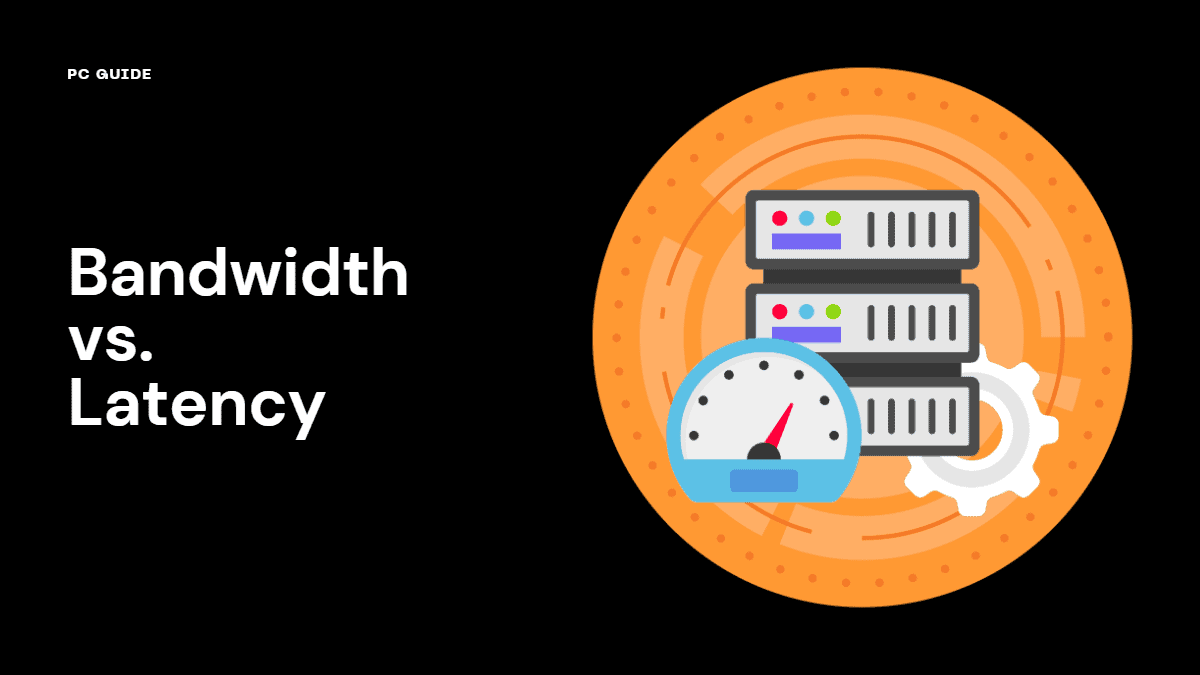Bandwidth vs. Latency – Explained

Table of Contents
Bandwidth and latency are two key factors that significantly influence your internet experience. They are the yin and yang of your network infrastructure, each playing a distinct role in how smoothly your online activities run.

What's Bandwidth?
Bandwidth refers to the amount of data transmitted over a network connection within a given period. Think of it as some pipe, and through it, data flows.
Bandwidth, often measured in megabits per second (Mbps), refers to the maximum amount of data that can be transferred over your network at any given time. It’s like the width of a highway – the wider it is, the more cars (or in this case, data) it can accommodate. Your download and upload speeds are directly tied to your bandwidth.
Whether you’re streaming a movie, playing an online game, or conducting a speed test, your bandwidth determines how fast data can travel from the internet to your devices. As a result, bandwidth is typically measured in megabits per second (Mbps) or gigabits per second (Gbps).
What's Latency?
Conversely, latency, often gauged by a ‘ping’ and expressed in milliseconds, signifies the duration it takes for a data packet to traverse from one point to another within your network. Think of it as the speed limit on a highway – it dictates the pace at which cars can travel. In the digital world of online gaming or video conferencing, a lower latency equates to minimal delay and a more seamless experience.
Latency, quantified in milliseconds (ms), is subject to various influencing factors. These include the physical distance between the data source and destination, network congestion, and the efficiency of the network equipment.
The choice of cable, be it an Ethernet cable or a fiber optic cable, can impact both your bandwidth and latency. Similarly, the quality of your router and other network hardware can also exert influence. Packet loss, a term referring to data that goes missing when journeying across a network, can also bear upon your latency and overall Quality of Service (QoS).
Understanding these facets of your network infrastructure can help you optimize your devices for superior upload speeds, download speed, and overall internet performance. Whether you’re conducting a speed test or simply browsing, every aspect, from the type of cable to the quality of service, plays a crucial role.
Understanding Latency vs. Bandwidth
To better grasp the difference between latency and bandwidth, let’s use an analogy: imagine you’re filling a glass with water. The size of the glass represents bandwidth, while the time it takes to fill it symbolizes latency.
Bandwidth determines the amount of data you can transfer at a specific time period, while latency dictates the amount of time it takes for the first byte of data to reach its destination.
Boosting Bandwidth
Boosting your bandwidth is akin to using a larger glass for water. Subscribing to a higher-speed internet plan from your Internet Service Provider (ISP) can increase your bandwidth, providing a wider “pipe” for data transmission.
This results in faster downloads and uploads, improving video quality for activities like video calls. However, it’s important to note that increasing bandwidth doesn’t necessarily reduce network latency.
Minimizing Latency
Minimizing latency, or the Round-Trip Time (RTT) it takes for signals to travel, involves different strategies. Using a wired internet connection instead of Wi-Fi can help, as can ensure your network equipment is up-to-date.
Selecting servers closer to your location can also reduce the number of packets that need to travel, resulting in lower latency. These steps can help decrease the time it takes for data to travel, enhancing your overall internet experience.
The Impact of Bandwidth vs. Latency on Online Activities

In the realm of online activities, both bandwidth and latency hold significant sway. They are the unseen forces that shape your digital experiences, from streaming videos to online gaming and video conferencing.
Streaming Videos
When it comes to streaming videos, bandwidth is the lifeblood that keeps the data flowing. It determines how much data can be transferred at a given time, with higher bandwidth ensuring smooth playback. However, high latency can throw a wrench in the works, causing buffering issues and delaying video loading, regardless of your bandwidth. This is where throughput, the actual rate of data transfer, comes into play.
Online Gaming
For online gaming, latency is the king. A low latency ensures a seamless gaming experience, allowing real-time reactions in the virtual world. High latency, on the other hand, can result in lag, affecting your gaming prowess. Bandwidth, while not as critical, still plays a role, especially when downloading large game files or playing online multiplayer games with high-quality graphics.
Video Conferencing
In the world of video conferencing, bandwidth and latency are two sides of the same coin. Sufficient bandwidth ensures a clear and smooth video stream, while low latency keeps audio and video transmission in sync. High latency can create noticeable delays in communication, making your conversations feel less like a face-to-face chat and more like a satellite broadcast.
Tips for Optimizing Bandwidth and Reducing Latency
Optimizing your bandwidth and reducing latency can significantly improve your online experience.
Here are some tips to help you achieve this:
- Upgrade Your Internet Plan: If you frequently find your internet speed lacking, it might be time to consider upgrading your internet plan. Higher bandwidth plans can provide faster data transfer rates, improving activities like video streaming and large file downloads.
- Use a Wired Connection: While Wi-Fi is convenient, a wired Ethernet connection can often provide a more stable and faster internet connection. Wired connections can reduce latency and are less likely to suffer from interference.
- Optimize Your Wi-Fi: If you can’t use a wired connection, there are still ways to optimize your Wi-Fi. Position your router centrally in your home, away from other electronics that could cause interference. Furthermore, ensure your Wi-Fi network is secured to prevent unauthorized users from using your bandwidth.
- Upgrade Your Hardware: If your router or modem is outdated, it could be slowing down your internet speed. Upgrading to newer, faster equipment can help increase your bandwidth and reduce latency.
- Close Unnecessary Applications: Applications running in the background can use up bandwidth and slow down your internet speed. Ensure you close any unnecessary applications, especially those that might be downloading or uploading data.
- Choose Off-Peak Hours: If possible, try to schedule heavy internet use during off-peak hours when fewer people are online. This can result in faster speeds and lower latency.
- Contact Your ISP: If you’ve tried everything and are still experiencing issues, it might be time to contact your Internet Service Provider (ISP). They can check for issues on their end and may be able to suggest solutions.
Remember, optimizing bandwidth and reducing latency is about more than just speed. It’s about ensuring a smooth, seamless online experience, whether you’re streaming, gaming, or just browsing the web.
FAQs
We’ll address some common questions related to these two crucial factors that impact your internet experience. Whether you’re a casual internet user or a tech enthusiast, understanding the difference between bandwidth and latency is essential for optimizing your online activities.
Let’s dive into the FAQs to gain a clearer understanding of these concepts and how they affect your internet performance.
How Do Bandwidth and Latency Affect Online Gaming?
Bandwidth impacts downloading game files, while latency affects real-time gameplay. Therefore, low latency is essential for a seamless gaming experience, while high bandwidth is beneficial for downloading game updates.
What is the difference between bandwidth and latency?
Bandwidth is like a highway with cars being the data. More lanes on the highway (higher bandwidth) mean more cars (data) can travel at the same time.
On the other hand, latency is how fast a car can get from one point to another. Even with many lanes, if there’s a lot of traffic or speed limits, it could take longer for a car to reach its destination. That’s high latency.
How does bandwidth impact internet speed and performance?
Picture satellite internet as a big spaceship that carries data from the internet to your device. If this spaceship can carry a lot of data at once, that’s high bandwidth. It means you can load web pages, download files, or watch videos faster because more ‘data-cars’ can travel at the same time.
What role does latency play in online gaming and video streaming?
Imagine playing a game or streaming a video over the internet, like sending letters back and forth. Latency is how long it takes for one letter (or piece of data) to travel from you to the game server or streaming service and back.
If this takes a long time (high latency), your game might lag, or your video might buffer because the responses to your actions are slow.
Can high bandwidth compensate for high latency?
Not really. Using our highway analogy, even if you have many lanes (high bandwidth), if there’s a lot of traffic or speed limits (high latency), the cars (data) still can’t get to the other side quickly.
So, even if you can send a lot of data at once, if it takes a long time for the data to travel (like with some satellite internet services), you might still experience delays.
How can I measure and test my bandwidth and latency?
You can use online tools to test both. These tools work by sending data to your device and measuring how quickly it arrives (bandwidth) and how long it takes to travel (latency). It’s like checking how fast cars can travel on a highway and how quickly they can get to the other side.
Just type “internet speed test” into a search engine, click on a result (make sure the website starts with “https” for secure connection), and follow the instructions to run the test.
Conclusion
Bandwidth and latency are both critical factors that impact your internet experience. While bandwidth determines the amount of data that can be transferred, latency determines the time it takes for data to reach its destination.
Depending on your online activities, you may need to consider both factors to ensure a smooth and uninterrupted experience. In addition, understanding the differences between bandwidth and latency allows you to make informed decisions to optimize your internet connection for your specific needs.